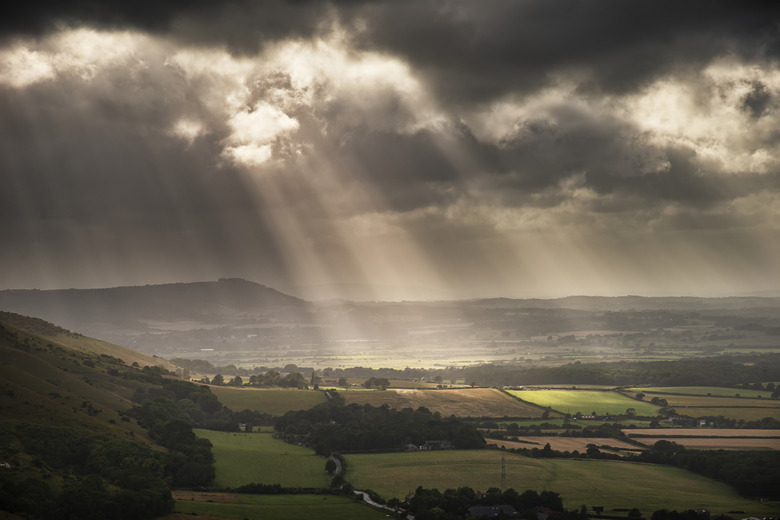The Effects Of Temperature Inversion
The effects of temperature inversions in the atmosphere range from mild to extreme. Inversion conditions may cause interesting weather patterns like fog or freezing rain or may result in deadly smog concentrations.
The atmosphere's largest temperature inversion layer stabilizes the Earth's troposphere.
What Is a Temperature Inversion?
What Is a Temperature Inversion?
Normally, atmospheric temperature decreases as altitude increases. Energy from the Sun heats the Earth's surface and that heat transfers to the atmosphere in contact with the Earth. The heat energy moves upward in the air column but spreads out as the altitude increases and the atmosphere thins.
Meteorologists, who are scientists who study weather, define inversion as "a layer of the atmosphere in which air temperature increases with height." This is true whether on the surface or elevated above the surface.
The inversion definition also explains that when the base of the inversion layer lies on the surface the inversion is called a surface-based temperature inversion. When the base of the inversion layer is above the surface, the inversion layer is called an elevated temperature inversion.
Convection Cell Circulation
Convection Cell Circulation
On clear calm mornings, the Sun's energy gradually heats the surface. The warmed surface heats the air in direct contact. The warmer, less dense air rises and denser cold air sinks into its place. The colder air warms and rises, with cooler air sinking down to the ground to be heated in turn. As the Sun rises the cyclic rising and falling air pattern called convection cells develops.
As ground temperature continues to increase, the convection cells rise higher and can reach 5,000 or more feet by early afternoon. By late morning the movement of air in convection cells may cause cumulus clouds to form and light, gusty winds of variable speed and direction to blow.
Later in the day, as the Sun's energy decreases and the surface cools, the convection cells become smaller. The water droplets forming the clouds evaporate and the breezes gradually decline.
Throughout the day, the air temperature is highest at the surface and decreases with altitude. However, a surface-based temperature inversion may develop after the Sun sets, especially if the air is calm, the sky is clear and the night is long.
Nocturnal Inversion Layers
Nocturnal Inversion Layers
As the Sun sets, the surface cools. The air in contact with the surface also cools. Air doesn't easily transfer heat and the warmer air above does not warm the colder air below. Without wind to stir the air, the colder air stays on the surface.
Without clouds, the surface warmth escapes faster. The longer the night, the colder the surface becomes. If the surface temperature drops below the dew point (the temperature to which air must be cooled to reach saturation), ground fog may form.
As the surface air cools and the air above remains warmer, the surface-based temperature inversion forms. The greater the temperature difference, the stronger the inversion. Stronger surface inversions form in winter because the nights are longer. If the weather conditions remain the same, the surface-based temperature inversion breaks down when the Sun comes up and warms the surface again.
High-Pressure Systems and Inversion Weather
High-Pressure Systems and Inversion Weather
If, however, a high-pressure system moves in, the inversion may stay in place for several days (and nights). As the layer of colder air becomes thicker the inversion becomes an elevated inversion layer. The air trapped under the inversion includes the moisture, smoke and pollutants released into the air mass. The air quality under an inversion layer deteriorates as the pollutants accumulate.
As the smoke and chemicals mix with water vapor, smog forms. The haze from smog reduces the Sun's energy and the ground doesn't gain as much energy. The surface and the air mass between the surface and the inversion layer stay cold and may become even colder.
A vicious cycle can develop as people use more heat, whether from fireplaces or fossil-fuel burning power plants, releasing more smoke and chemicals into the trapped cold air mass and increasing the smog haze that reduces the Sun's energy. Severe smog events in 1948 in Donora, Pennsylvania, (USA) and in 1952 in London, England, resulted from elevated temperature inversion layers.
Inversion Layers and Freezing Rain
Inversion Layers and Freezing Rain
When the elevated temperature inversion layer is above freezing temperature and the underlying cold air temperature is at or below freezing temperature, freezing rain occurs.
Rain falls as a liquid through the relatively warmer air mass of the inversion layer. When the liquid rain enters the colder air mass below the inversion layer, the raindrops freeze to form freezing rain.
Topography and Inversion Layers
Topography and Inversion Layers
Topography plays an important role in developing and holding inversion layers in place. Cold air from higher elevation sinks and pools in valleys and low areas such as coastlines.
The cold air chills the surface and separates the surface from the warmer air. Surrounding ridges and hills protect valleys from winds which could mix the air masses and disrupt the inversion pattern.
Earth's Biggest Temperature Inversion
Earth's Biggest Temperature Inversion
Weather patterns occur in the bottom layer of the atmosphere, the troposphere. Above the troposphere lies the stratosphere. In the stratosphere, the Sun's energy reacts with the atmosphere to form a global ozone layer.
This ozone layer absorbs some of the Sun's energy resulting in a global elevated inversion layer above the troposphere. This inversion layer helps hold the Earth's surface warmth in the troposphere.
Cite This Article
MLA
Blaettler, Karen G. "The Effects Of Temperature Inversion" sciencing.com, https://www.sciencing.com/effects-temperature-inversion-8447465/. 22 November 2019.
APA
Blaettler, Karen G. (2019, November 22). The Effects Of Temperature Inversion. sciencing.com. Retrieved from https://www.sciencing.com/effects-temperature-inversion-8447465/
Chicago
Blaettler, Karen G. The Effects Of Temperature Inversion last modified March 24, 2022. https://www.sciencing.com/effects-temperature-inversion-8447465/
